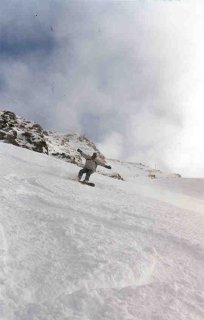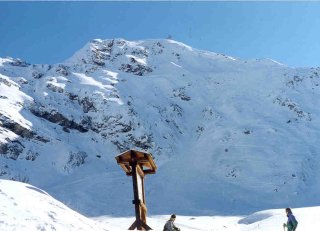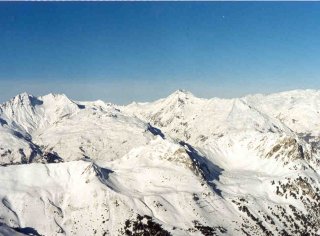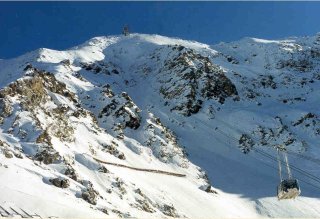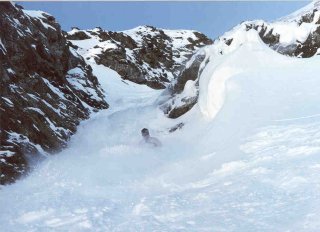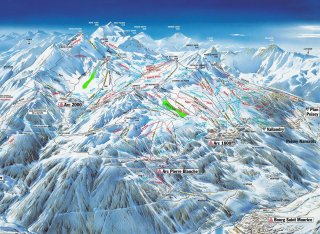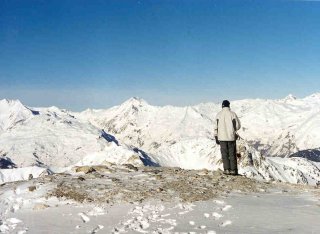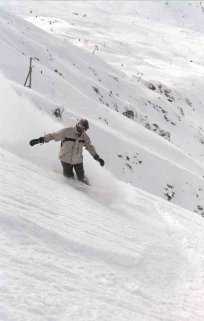I knew two things about Les Arcs prior to our visit.
Les Arcs: Something for Everybody
-
I’d seen pictures
of lunatics with space helmets on, hurtling down the speed skiing run
at 150 mph. -
A lot
of people choose to spend their winter seasons in the resort.
But nothing could have prepared me for the sheer diversity,
size and quality of terrain that’s contained within Les Arcs. Generally, when
I’ve visited a resort I like to think I’ve covered most of it during my stay,
but let me say this right from the start: I didn’t even come close.
You could spend months in Les Arcs and you’d still be exploring new terrain
– and that’s not including the five or six nearby resorts and the immense
backcountry opportunities that are available.
n
Les Arcs is located two and a half hours’ drive from the Geneva airport, in
the heart of the French Alps. The resort area contains six small villages spread
throughout the ski area, all of which have different features and characteristics,
allowing you to choose a village that will best be suited to your needs. The
resort is also located a short drive from several other ski resorts both in
France and Italy, making it an ideal base for those wishing to sample the delights
of this region (although this may be more difficult depending on your choice
of location, as some villages are more accessible than others).
|
|
Les Arcs is currently undergoing a massive expansion and improvement program,
including the building of new hotels and apartments and the expansion of snowmaking
facilities. These improvements are in no small part due to a massive investment
in the resort by the North American giant, Intrawest.
A cable car link between Les Arcs and the neighbouring resort of La Plagne is
due to open in time for the 2002/2003 season, and this will lead to the formation
of a stupidly large ski area to rival any in the world. The cable car is to
be built between Plan-Peisey (1650 m, Les Arcs) and Montchavin Les Coches (1470
m, La Plagne). Once completed, the resulting area will have nearly 420 km of
pistes, three glaciers and two peaks over 3000 m and will be one of the world’s
largest ski areas.
ACCOMMODATION:
1) Bourg-Saint-Maurice:
Situated on the valley floor, Bourg-Saint-Maurice
is easily reached by TGV (high speed train) from most European cities, or by
bus from the nearby Geneva airport. The free valley bus and funicular railway
(7 minutes to Arc 1600) provide easy and direct access to the ski area. However,
Bourg-Saint-Maurice is not very lively and doesn’t give you ski in/out opportunities,
all of which is reflected in the price of accommodation
2) Arc 1600:
A small-scale (5,000-bed) car-free resort, Arc
1600 overlooks Bourg-Saint-Maurice (access via the funicular railway). Most
of the residences in 1600 tend to be chalets or private hire. Ski in/out residences
are available. Arc 1600 is allegedly not as lively as Arc 1800, so if it’s nightlife
you’re after, I’d stick with 1800.
3) Arc 1800:
Arc 1800 is situated at the point where the ski
areas of Arc 2000, Peisey-Vallandry and Arc Pierre Blanche (1600) all meet.
There are a large number of shops, restaurants and night-clubs situated in the
village which make it the liveliest (and I dare say, the noisiest) of the six
villages. The village is car-free, with 19,000 beds, all of which are close
to the lifts.
|
Some of the steeper terrain at Les Arcs is located directly |
4) Arc 2000:
Located on the other side of the ski area from
the other villages, Arc 2000 offers guaranteed snow due to its altitude and
location. You can drive to the village, but as it is also car-free – you’ll
have to park your car and walk around the village. Arc 2000 is a smaller village
with 6,000 beds. It also tends to be the most expensive village due to it’s
location, and there can be a slight delay before the lifts open after a heavy
snowfall while avalanche control operations are completed.
5) Villaroger:
Villaroger is situated at an altitude of 1100 m at the base of the Aiguille
Rouge. Due to the low snow cover at this altitude, I never visited the village,
so I wouldn’t like to speculate on what it is like. According to the brochure,
it is small (300 beds) comprised of mostly apartments and private rentals.
6) Vallandry and Plan Peisey (1650m):
These two villages are located five minutes apart, and are becoming the focus
of increased development due to the La Plagne/Les Arcs cable car development.
We stayed in the Chalet les Melezes in Plan Peisey, run by the British company
Alpine Action. The two villages have a number of decent shops and restaurants
and there are a couple of more lively bars in Vallandry, most notably the Mont
Blanc. Our chalet boasted full board and a ski in/out location near the lifts.
Unfortunately, boast was about as good as it got, as they erred on both my airport
transfers, there was never enough food, no hot water and the heating seemed
to have a mind of its own. This, coupled with the most disorganized management
I have ever had the misfortune to deal with, has made me vow never to set foot
in the place again.
|
The view from atop Aiguille Rouge is breathtaking |
That aside, I would definitely stay in Vallandry/Plan Peisey again, as it has
a nice, relaxed overall atmosphere combined with a number of more lively bars.
A large number of families also choose to stay at this end of the resort, presumably
because of its quieter nature and the larger number of chalets. Despite their
remote appearance, Vallandry/Plan Peisey are only one chairlift and a long flat
blue run away from the main lifts at Arc 1800.
Beginners are well served with four or five ski
schools offering all manner of lessons. Intermediates may take their pick of
red runs, or experiment with powder or tree runs adjacent to the marked slopes
without any fear of getting lost or stuck.
For the more adventurous amongst you, it’s just
a matter of finding what you want. You want trees? You got them in abundance,
both in and around Plan Peisey and off the back side of the Arpette lift, and
in the huge area between lifts 31 and 41. You want bumps? They’ve got bumps
as big as small cars here, especially on the Arc 2000 side. You want corduroy?
You’ve got access to miles of it above 1600, 1800 and over on the 66 lift. More
importantly, do you want powder? Take your pick, mate – the place is chock full
of powder runs, it’s just a matter of knowing which ones to do first and which
ones to save until later.
Most of the powder runs we found (except for the
trees on the frontside of the mountain) were in and around Arc 2000. The area
to the right of the No 36 chair has great potential for first tracks on the
morning after a snowfall: not too steep, and a great way to get down to the
lifts in Arc 2000 (it tends to track out pretty quickly, though). The run under
the Arc 2000 gondola is a quality powder run, and you get the added advantage
of being able to plan your route down from the comfort of your seat. The area
to the left of the No. 45 lift was a firm favourite of mine, and seemingly not
popular with many other people as we always had fresh tracks there.
|
The Aiguille Rouge cable car
The frozen waterfall below Aiguille Rouge |
The main bulk of the really steep and deep stuff,
however, is reached by taking the cable car right to the top of the Aiguille
Rouge at an altitude of 3226m. The Aiguille Rouge is a 7km black run which takes
you into Villaroger, a vertical drop of over 2000m. However from the top of
the run you can drop back down into the area above Arc 2000, allowing you access
to some of the best snow on the mountain.: We discovered this region at about
11 o’clock on the first morning (beginner’s luck), and returned to it repeatedly
throughout the week, especially on the third day after two feet of fresh had
fallen overnight.
There are basically 3 “runs” there, although none
is signposted or marked, and we often plumbed for the “making it up as we went
along” approach. The first is the Olympic Speed Skiing run (see below) which
is usually groomed, although fortunately for us it was untracked at the time,
allowing over 1,500 feet of untracked vert. The second run is a wider, more
open powder bowl to the left which was always wind crusted when I was on it,
but was ultimately still quite satisfying. The third run is a narrow gully (see
picture) which brings you out in the flatter open area just above Arc 2000.
All three of these runs were top quality, especially on the third
day, which was without a doubt the best non-helicopter day of my snowboarding
life. If you’re feeling even more adventurous, there is another very narrow
gully in between the speed run and the aforementioned gully which gets gradually
narrower and narrower until you reach a frozen waterfall which requires mandatory
air to reach the bottom (it’s only about 6 or 7 foot high, but it’s a bloody
good laugh).
There were runs too numerous to mention that we never got to explore, including
the Grand Col and a host of others. The long flat traverses to reach one end
of the resort to the other were in my mind the only downside to the whole Les
Arcs experience, although these may be avoided by taking lifts in between if
you wish. These are (quite literally) a real pain for those of us who prefer
one plank of wood to two, but what the hell – you can’t have everything.
THE RESORT
|
Les Arcs trail map (click image to open a full-sized |
Upon first inspection, the ski area appears to be very spread out and disorganized,
but there’s just so much of it, you’ll need a day to find your bearings. Les
Arcs is basically divided into two sections: the area around Arc 2000, where
a lot of the steeper, more challenging terrain is located, and the area on the
other side of the ridge above Plan Peisey, Arc 1600 and 1800. The snow quality
was good for the time of year, despite one of the shakiest starts to the European
season for many years. There were tons of snow at any altitude above 1700 or
1800 m, but the cover was a bit sketchy lower down at the start of our trip.
About halfway through our ten-day visit, the big snowstorm we’d all been waiting
for arrived, and we could finally ski to our door without any fear of hearing
that horrible rock grinding noise to which we’d all become accustomed. The pistes
were generally of good standard, the green/blue/red/black grading system was
strictly adhered to, and all of the runs were clearly marked. There was therefore
no danger of beginners ending up where they shouldn’t be.
Snowmaking was adequate in required areas, except on the runs down to 1800,
which are very heavily used and began to wear a bit thin at times. All the novice
slopes were groomed daily, and some of the other runs are left to develop naturally
(a list of groomed runs is available at the bottom of most lifts, or just ask
the lifties).
The lift system is confusing at first due to the immense amount of ground it
has to cover, but it actually is quite efficient. The queues were not very big,
and certainly they never started to get annoying, despite our visit at a busy
time of year. Some of the lifts, however, were better at dispersing crowds than
others – some of the chairs are high-speed quads, while others are rickety old
doubles. There are a lot of surface lifts, but because of the way the system
is arranged I never had to use one in the entire time that we were there.The
lifties were quite friendly and helpful, unlike those found at many other European
resorts. I can only speculate that the attitude of Canadian/American lift personnel
has finally made it over the Atlantic.
|
Where’s my heli?
|
Unlike many North American locations, ducking boundary ropes is not considered
an offense here, so if you’re confident enough you can go wherever the fancy
takes you without any danger of having your lift pass confiscated. Having said
that, the Les Arcs backcountry looks pretty hardcore in places, and I’d seriously
recommend a guide. There are four or five guiding companies all competing for
your custom, so prices tend to be sensible. There are loads of officially recognized
off-piste routes, including one which takes you into Italy, and you can heli-ski
from the nearby resort of La Rosiere (local companies can arrange this for you).
The mountain facilities were good, although those of us Europeans used to
skiing in North America are slightly spoiled in this respect, especially when
it comes to food and drink prices. Certainly, as far as European resorts are
concerned the facilities were excellent and the restaurants quite reasonably
priced – even in the Arc 2000 restaurants which I expected to be overpriced.
We spent eight out of our ten lunches in Arc 2000, and enjoyed a fantastic tagliatelle
bolognaise for 48FF.
Off the slopes, the different villages obviously all have different atmospheres,
and the facilities vary depending on which village you are in. The restaurants
and bars were all of decent standard and not overpriced (about 100FF for a meal
with wine, although this will obviously vary from place to place). If you are
looking for more of a drinking holiday than a snowsliding holiday, Arc 1800
is apparently the place to go – but I’m certain to return to Vallandry.

